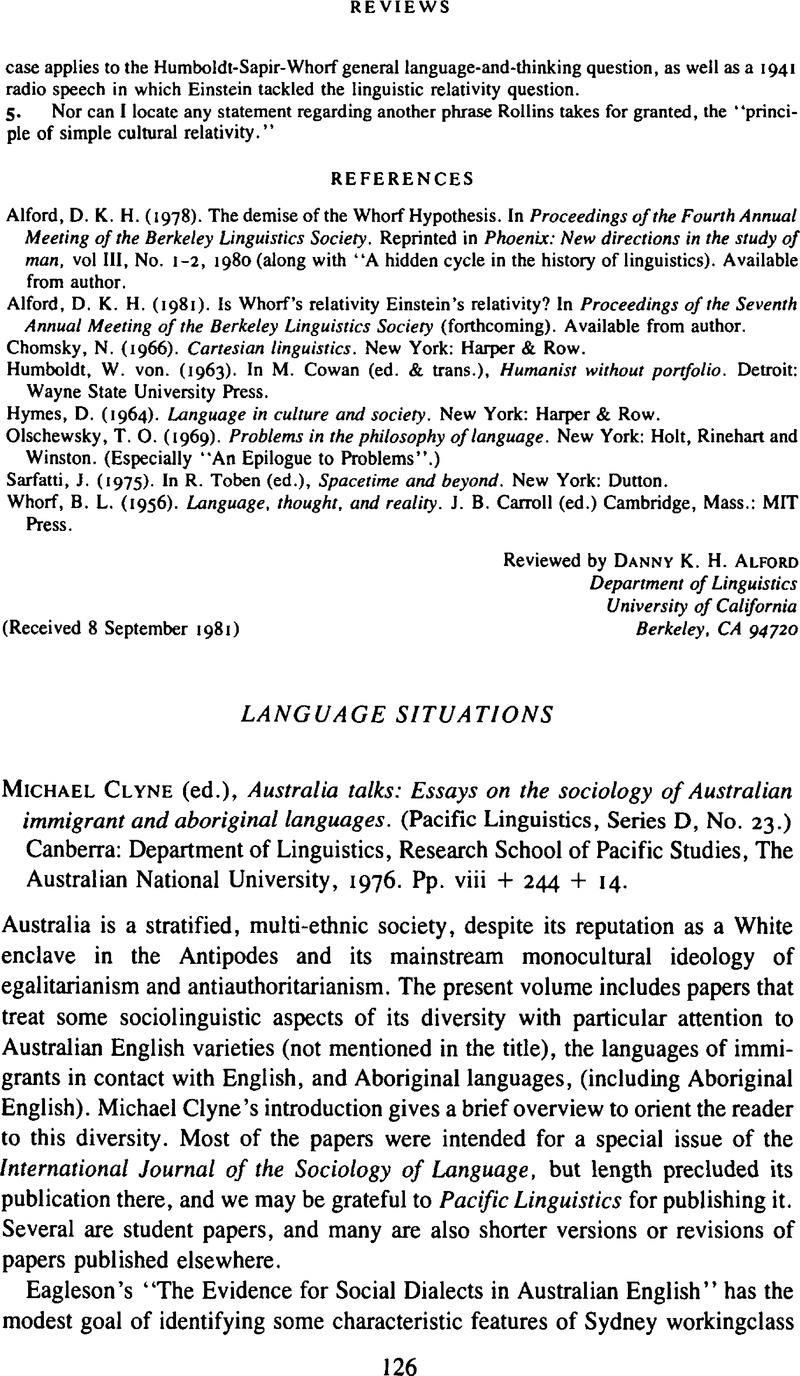No CrossRef data available.
Article contents
Language Situations - Michael Clyne (ed.), Australia talks: Essays on the sociology of Australian immigrant and aboriginal languages. (Pacific Linguistics, Series D, No. 23.) Canberra: Department of Linguistics, Research School of Pacific Studies, The Australian National University, 1976. Pp. viii + 244 + 14.
Published online by Cambridge University Press: 18 December 2008
Abstract
An abstract is not available for this content so a preview has been provided. Please use the Get access link above for information on how to access this content.

- Type
- Book Review
- Information
- Copyright
- Copyright © Cambridge University Press 1982
References
REFERENCES
Baker, S. J. (1945). The Australian language. An examination of the English language as used in Australia, from convict days to the present, with special reference to the growth of indigenous idiom and its use by Australian writers. Sydney: Angus & Robertson.Google Scholar
Clyne, M. (1977). The speech of foreign workers in Germany. Language in Society 6: 268–74.CrossRefGoogle Scholar
Cochrane, G. R. (1959). The Australian English vowels as a diasystem. Word 1: 69–88.CrossRefGoogle Scholar
Craig, D. R. (1977). Creole languages and primary education. In Valdman, A. (ed), Pidgin and creole linguistics. Bloomington: Indiana University Press.Google Scholar
Crowley, T., & Rigsby, B. (1979). Cape York Creole. In Shopen, T. (ed), Languages and their stajus. Cambridge, Mass.: Winthrop Publishers.Google Scholar
DeCamp, D. (1971). Introduction: The study of pidgin and creole languages. In Hymes, D. (ed.), Pidginization and creolization of languages. Cambridge University Press.Google Scholar
McDavid, R. I. (1977). Review of Mitchell & Delbridge 1965. Language 53:679–83.CrossRefGoogle Scholar
Mitchell, A. G., & Delbridge, A. (1965). The speech of Australian adolescents. Sydney: Angus & Robertson.Google Scholar
MÜhlhäusler, P. (1979). Remarks on the pidgin and creole situation in Australia. Newsletter (New Series No. 11). Canberra: Australian Institute of Aboriginal Studies.Google Scholar
Neustupý, J. V. (1970). Basic types of treatment of language problems. Linguistic Communications 1: 77–98. Clayton, Victoria: Monash University.Google Scholar
Ramson, W. S. (1966). Australian English. An historical study of the vocabulary 1788 –1898. Canberra: Australian National University Press.Google Scholar
Ramson, W. S.(ed.) (1970). English transported. Essays on Australasian English. Canberra: Australian National University Press.Google Scholar
Sutton, P. (1979). Wik: Aboriginal society, territory and language at Cape Keerweer, Cape York Peninsula, Australia. Unpublished Ph.D. thesis. University of Queensland.Google Scholar
Sutton, P. & Rigsby, B. (1979). Linguistic communities and social networks on Cape York Peninsula. In Wurm, S. (ed), Australian linguistic studies. (Pacific Linguistics, Series C, No. 54). Canberra: Department of Linguistics, Research School of Pacific Studies, The Australian National University.Google Scholar




